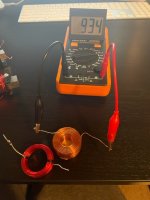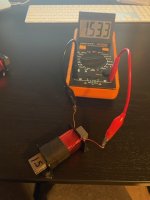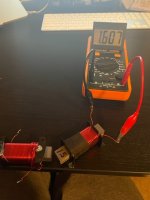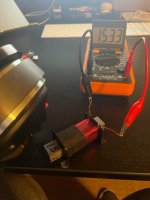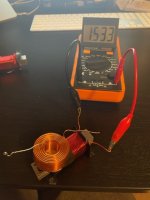Most information on distance has to do with air core inductors. The little information on iron core I've seen is conflicting, so I'm hoping for a consensus here.
Specifically, for an ERSE Super Q 2.7mH laminated iron core inductor and Altec 416 woofer with flux density of 11,000 gauss, what would the recommended distance be between them?
I'm a simple DIY'er with very limited electrical measuring tools, so thanks for the help.
Specifically, for an ERSE Super Q 2.7mH laminated iron core inductor and Altec 416 woofer with flux density of 11,000 gauss, what would the recommended distance be between them?
I'm a simple DIY'er with very limited electrical measuring tools, so thanks for the help.
I just tested this for you. At 2 inches there is no effect. At 1 inch my 1.52mH air core changed to 1.55mH, so not much. When I made the iron core stick to the magnet it went to 1.77mH. Even just a millimeter away and it was still only 1.57mH. I also tested air core and same results. I tried both ferrite magnet and neo magnet. Basically, it's not worth worrying about. Just don't have the magnet touching anything.
Even placing two inductors near each other doesn't do much. They have to be really close to start making big changes and even then it's not that much. The only way I could get a big change it to put something metel in the center of an air core, definitely don't do that. A small screw inside the hole of an air core will totally throw it off. 1 inch is enough space.
Interestingly, placing two iron cores end to end makes a pretty big difference. Or even one end of an iron core close to another iron core end. That should be avoided. Iron cores don't like to be near other iron cores. Air cores don't seem to mind as much. I stacked two air cores on top of each other actually touching and the values did not change. I have read plenty of people claim otherwise, but I can't reproduce it.
Even placing two inductors near each other doesn't do much. They have to be really close to start making big changes and even then it's not that much. The only way I could get a big change it to put something metel in the center of an air core, definitely don't do that. A small screw inside the hole of an air core will totally throw it off. 1 inch is enough space.
Interestingly, placing two iron cores end to end makes a pretty big difference. Or even one end of an iron core close to another iron core end. That should be avoided. Iron cores don't like to be near other iron cores. Air cores don't seem to mind as much. I stacked two air cores on top of each other actually touching and the values did not change. I have read plenty of people claim otherwise, but I can't reproduce it.
Do you think this is connected with the proximity of the iron?
I'd be interested in the inductor core saturation and the distortion that might occur, especially at different levels and at different distances.
I'd be interested in the inductor core saturation and the distortion that might occur, especially at different levels and at different distances.
I could probably run REW sweeps with the xo board outside the cab. Then place a loose iron core near an iron core on the board and compare the REW results. Not sure how loud it would need to be for saturation to take place. The iron cores are only in the woofer circuit so they could potentially get maybe 50 watts.
Im not smart enough with all this magnetic field stuff to speak about iron proximity. I just like to test stuff and see what happens.
Im not smart enough with all this magnetic field stuff to speak about iron proximity. I just like to test stuff and see what happens.
#Samps, nice of you do all that work for us. I'm also interested in your ideas about AllenB's question. HeyBill
Perhaps you should connect both coil either parallel or in series then measure the total inductance with different placement and report back the result.Even placing two inductors near each other doesn't do much. They have to be really close to start making big changes and even then it's not that much.
Old School Sound,
Since the permeability of iron (or steel) is much higher (say 1000x) than that of free space (or air), most of the flux is supposed to be contained in and around the core itself. However, this changes if the iron core has an external gap (used to prevent saturation), as there would then be some fringing flux (leak) from around the gap area, as it consists of lower permeability material namely, air.
Note that it is this flux that travels distances and induces voltages in unwanted conductors nearby. So, restrict the flux, and everything will be fine. Distance is just one way to achieve this.
Since the permeability of iron (or steel) is much higher (say 1000x) than that of free space (or air), most of the flux is supposed to be contained in and around the core itself. However, this changes if the iron core has an external gap (used to prevent saturation), as there would then be some fringing flux (leak) from around the gap area, as it consists of lower permeability material namely, air.
Note that it is this flux that travels distances and induces voltages in unwanted conductors nearby. So, restrict the flux, and everything will be fine. Distance is just one way to achieve this.
Yes, I have a feeling the fact that my test had all of the parts not connected in any way may have prevented them from interacting as they would connected in a xo network. I’ll redo this test with different connections. Thanks for pointing that out!Perhaps you should connect both coil either parallel or in series then measure the total inductance with different placement and report back the result.
Connecting the inductors in series definitely changed the results. I couldn’t figure out a way to test the speaker connected to the inductor to test.
lots of random configurations here at different distances. All in series. Most didn’t make much difference but more than the last test.
lots of random configurations here at different distances. All in series. Most didn’t make much difference but more than the last test.
Attachments
-
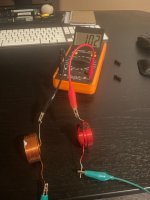 90666387-0229-4B6B-8816-5CA34227B2B5.jpeg44.5 KB · Views: 75
90666387-0229-4B6B-8816-5CA34227B2B5.jpeg44.5 KB · Views: 75 -
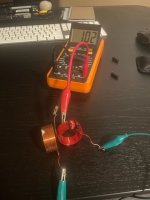 B0C93947-F26F-4545-BD68-D90BD48CEC40.jpeg43.8 KB · Views: 72
B0C93947-F26F-4545-BD68-D90BD48CEC40.jpeg43.8 KB · Views: 72 -
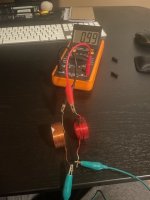 0A6E9E5D-C6A2-4991-BA27-93A149047D3A.jpeg43 KB · Views: 83
0A6E9E5D-C6A2-4991-BA27-93A149047D3A.jpeg43 KB · Views: 83 -
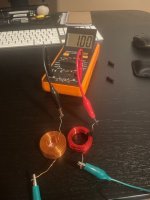 2D9F3647-557B-4D7C-8865-05DEFA4E9B36.jpeg44.5 KB · Views: 81
2D9F3647-557B-4D7C-8865-05DEFA4E9B36.jpeg44.5 KB · Views: 81 -
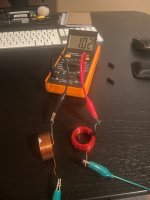 F542CA0C-F563-4BE9-8996-EC2822E3ED9F.jpeg44 KB · Views: 65
F542CA0C-F563-4BE9-8996-EC2822E3ED9F.jpeg44 KB · Views: 65 -
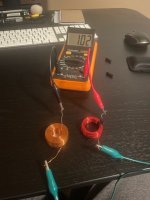 D2ABFCA1-B1A1-4836-9C8E-C03C94FAF73C.jpeg45.2 KB · Views: 68
D2ABFCA1-B1A1-4836-9C8E-C03C94FAF73C.jpeg45.2 KB · Views: 68 -
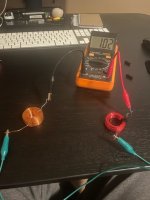 6FFBE1BB-EBC0-466B-8E59-88E1C8095D99.jpeg44.4 KB · Views: 71
6FFBE1BB-EBC0-466B-8E59-88E1C8095D99.jpeg44.4 KB · Views: 71 -
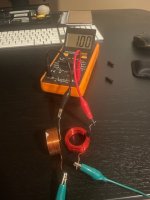 2F34F3F8-968A-4A34-8426-85B53590C606.jpeg44.1 KB · Views: 73
2F34F3F8-968A-4A34-8426-85B53590C606.jpeg44.1 KB · Views: 73 -
 1F911570-4FBA-4EF4-B847-1921295C2DA1.jpeg46.6 KB · Views: 82
1F911570-4FBA-4EF4-B847-1921295C2DA1.jpeg46.6 KB · Views: 82 -
 B48C2DBD-2BD5-49BC-9894-3CE713D59E8C.jpeg44.4 KB · Views: 72
B48C2DBD-2BD5-49BC-9894-3CE713D59E8C.jpeg44.4 KB · Views: 72 -
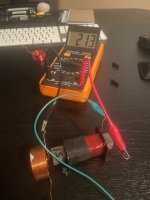 05DCBBED-7A9E-473D-AD53-7AB7F9C3D69F.jpeg45.6 KB · Views: 89
05DCBBED-7A9E-473D-AD53-7AB7F9C3D69F.jpeg45.6 KB · Views: 89 -
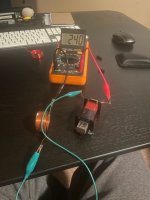 BF067F65-6BF5-43C1-9975-775E4B229748.jpeg47.1 KB · Views: 68
BF067F65-6BF5-43C1-9975-775E4B229748.jpeg47.1 KB · Views: 68 -
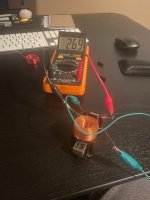 9A35CFE7-F481-46F3-9801-4C24FB42E101.jpeg44.1 KB · Views: 69
9A35CFE7-F481-46F3-9801-4C24FB42E101.jpeg44.1 KB · Views: 69 -
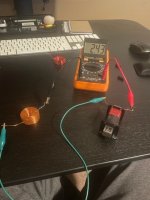 10943DA3-E77C-4236-BA8E-C1C672E032FE.jpeg47.9 KB · Views: 83
10943DA3-E77C-4236-BA8E-C1C672E032FE.jpeg47.9 KB · Views: 83 -
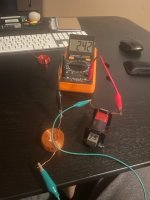 6A19F000-06F4-438B-8A67-D98DA364E817.jpeg45.4 KB · Views: 63
6A19F000-06F4-438B-8A67-D98DA364E817.jpeg45.4 KB · Views: 63 -
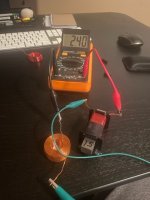 0747F69D-800C-4889-9579-F9ADA6A0DBA5.jpeg45.6 KB · Views: 83
0747F69D-800C-4889-9579-F9ADA6A0DBA5.jpeg45.6 KB · Views: 83 -
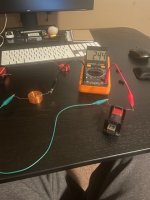 79F05D0F-2430-4B5F-8EB5-FE6561D4F4B9.jpeg46.3 KB · Views: 69
79F05D0F-2430-4B5F-8EB5-FE6561D4F4B9.jpeg46.3 KB · Views: 69
Iron cores are picky about being near iron cores. If you need a really big mH just butt up two iron cores end to end and you get almost double the value They have to be touching though.
Attachments
-
 0927BFE6-2E5F-46F0-B694-7BE5C3022C82.jpeg47.3 KB · Views: 85
0927BFE6-2E5F-46F0-B694-7BE5C3022C82.jpeg47.3 KB · Views: 85 -
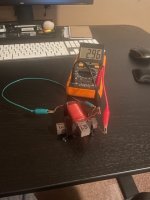 3D8648D5-7744-42D1-8DAB-B2EA36968BE2.jpeg44.4 KB · Views: 67
3D8648D5-7744-42D1-8DAB-B2EA36968BE2.jpeg44.4 KB · Views: 67 -
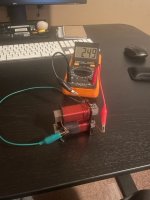 86DF697D-CFF7-475D-97C3-3B9AEC1F5857.jpeg45.7 KB · Views: 61
86DF697D-CFF7-475D-97C3-3B9AEC1F5857.jpeg45.7 KB · Views: 61 -
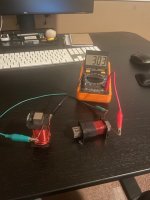 B7BA5D52-64DB-4ABD-AD78-641B68A4C2AF.jpeg45.5 KB · Views: 57
B7BA5D52-64DB-4ABD-AD78-641B68A4C2AF.jpeg45.5 KB · Views: 57 -
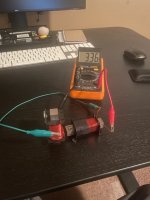 CF4ADB24-86A5-4D10-A6BD-BAF1A0A69ED3.jpeg45 KB · Views: 54
CF4ADB24-86A5-4D10-A6BD-BAF1A0A69ED3.jpeg45 KB · Views: 54 -
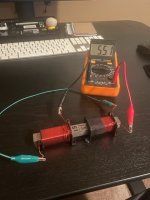 D02B5B3F-B3DC-4549-8AC4-FBA23DB26E53.jpeg47.7 KB · Views: 92
D02B5B3F-B3DC-4549-8AC4-FBA23DB26E53.jpeg47.7 KB · Views: 92 -
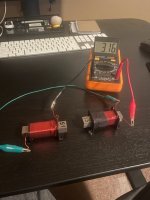 9155DC99-57F7-4355-BB5C-419CD35D90C4.jpeg47.9 KB · Views: 61
9155DC99-57F7-4355-BB5C-419CD35D90C4.jpeg47.9 KB · Views: 61 -
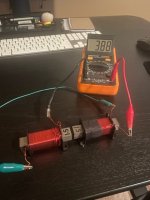 6CF34D09-003B-4E8A-A868-5E6EB20D399A.jpeg48.4 KB · Views: 72
6CF34D09-003B-4E8A-A868-5E6EB20D399A.jpeg48.4 KB · Views: 72 -
 2274DC93-65A2-41AD-9077-46CD469E7A3A.jpeg47.9 KB · Views: 73
2274DC93-65A2-41AD-9077-46CD469E7A3A.jpeg47.9 KB · Views: 73 -
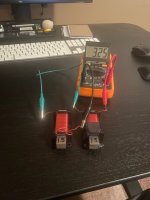 E1F791AD-DC7E-4FDA-A6A1-137773972159.jpeg44.9 KB · Views: 63
E1F791AD-DC7E-4FDA-A6A1-137773972159.jpeg44.9 KB · Views: 63 -
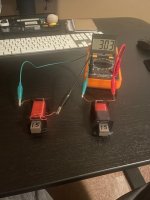 AADC6057-9997-4E9A-8416-E8A6860F0F9F.jpeg46.2 KB · Views: 64
AADC6057-9997-4E9A-8416-E8A6860F0F9F.jpeg46.2 KB · Views: 64 -
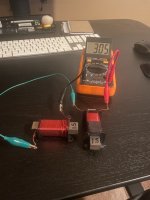 2F49D5DE-1A80-4619-B06D-155E47A2A836.jpeg46.4 KB · Views: 69
2F49D5DE-1A80-4619-B06D-155E47A2A836.jpeg46.4 KB · Views: 69 -
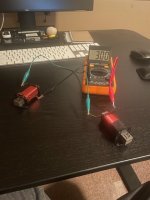 46F0F015-FB53-44BA-8978-D2A6373FB609.jpeg45.9 KB · Views: 75
46F0F015-FB53-44BA-8978-D2A6373FB609.jpeg45.9 KB · Views: 75
Thank you for your findings! 👍 👍Iron cores are picky about being near iron cores...
Samps,
Thanks for all your work! Quite a learning experience.
Newvirus2008,
Thanks for adding some clarity of the differences between the two cores.
Thanks for all your work! Quite a learning experience.
Newvirus2008,
Thanks for adding some clarity of the differences between the two cores.
I tried to test if there is any difference in distortion when the inductors are placed near each other. I ran three sweeps for each configuration at volume 30-40-50. Mic was near clipping so I didn't try louder. These were done close mic on the woofer (deltalite 2515). In a ported cab, in room. 1/48 smoothing on the responses, 1/12 on the distortion.
3 of just raw woofer
3 with a pair of 1.5mh iron cores in series set 8 inches apart
3 with the same iron cores but this time they were stacked directly on top of each other lengthwise, but no physical contact between wire or iron.
I do not see any change in distortion with the cores stacked other than the change based on the mH value changing due to them being close to each other.
I tried to upload the mdat but it says it's too large.



3 of just raw woofer
3 with a pair of 1.5mh iron cores in series set 8 inches apart
3 with the same iron cores but this time they were stacked directly on top of each other lengthwise, but no physical contact between wire or iron.
I do not see any change in distortion with the cores stacked other than the change based on the mH value changing due to them being close to each other.
I tried to upload the mdat but it says it's too large.
Samps,
Thanks for the extra effort by testing with a speaker! How far would you say the inductors where from the woofer magnet?
Thanks for the extra effort by testing with a speaker! How far would you say the inductors where from the woofer magnet?
I tested placing an iron core inductor in series with the woofer very near the magnet. It made zero difference. You can’t even see two traces in the graph. This was done with a neo magnet which I have read has a more contained magnetic field. I don’t have a ferrite woofer handy to test. I had the inductor almost touching the magnet which leads me to believe you would be fine with very little space away from the magnet.
You might worry more about inductor to inductor crosstalk. A little demo here that I made when I heard my speaker playing music before I even connected the speaker cables. 🙂
Although we may already know the answer, would it make a difference between the 416 (alnico) and the 416C (ceramic) woofers?
Large alnico structures tend to be "potted" and I mean magnetically, so they "try" to have little external flux; while large ferrites are brute force systems, with A LOT being spilled around.
Easily 40% or more.
The quoted 11.000 Gauss are at the gap, and might be same or close in both designs, but what affects a nearby inductor is external/losses field which might show a 5:1 to 10:1 difference comparing both.
As always, measuring rules (thanks Samps ), but even the crude "sticking a screwdriver to magnet" test can tell a lot.
Easily 40% or more.
The quoted 11.000 Gauss are at the gap, and might be same or close in both designs, but what affects a nearby inductor is external/losses field which might show a 5:1 to 10:1 difference comparing both.
As always, measuring rules (thanks Samps ), but even the crude "sticking a screwdriver to magnet" test can tell a lot.
- Home
- Loudspeakers
- Multi-Way
- Distance to keep iron core inductor from 15" woofer magnet


